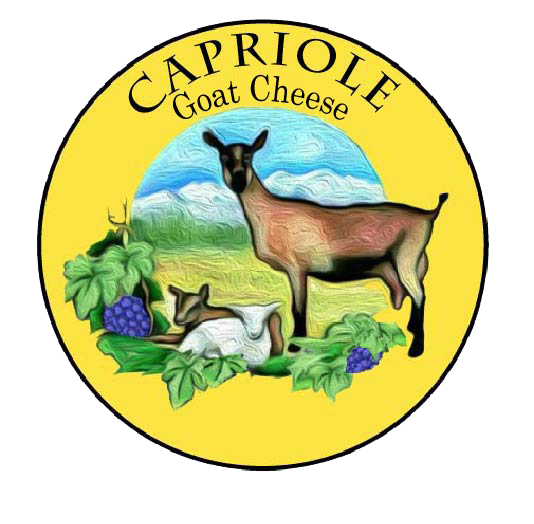Cheese 101: Mold
Mold Education for Capriole’s Ripened Cheeses
What makes soft-ripened cheeses so special? Love, care… and mold. Yep, you heard us right—we love moldy cheese.
If you’re new here (or just new to the world of artisan cheese), this might sound a little wild. But the truth is, mold has been part of cheesemaking for centuries. Long before anyone understood the science, early cheesemakers noticed that certain cheeses developed beautiful, flavorful rinds when left to age in caves, cellars, or barns. Those fuzzy coatings? Mold— the good kind.
In cheesemaking today, these molds aren’t an accident. They’re an essential ingredient that helps shape the flavor, texture, and character of some of the world’s best cheeses—including ours. That’s why we actively coax mold to grow on our surface ripened and aged cheeses.
The Science of Mold (A Love Story)
Sofia, Wabash Cannonball, and Julianna
In cheesemaking, mold isn’t just tolerated—it’s cultivated. It’s what gives bloomy-rind cheeses like Brie and Camembert their soft, snowy crust. It’s what creates the blue veining in Roquefort. And it’s what helps Capriole’s very own ripened cheeses, Piper’s Pyramide, Sofia, Wabash Cannonball, and Flora, develop their delicate, wrinkled rinds and lush interiors.
Here’s a quick breakdown of some of the molds at play in our creamery:
Penicillium Candidum – The “white mold” that creates that soft, mushroomy bloom on Old Kentucky Tomme and Julianna. This is a more aggressive mold.
Geotrichum Candidum – A gentler mold, known for its brainy, wrinkled surface that you can find on our ripened cheeses
Brevibacterium linens (B. linens) – The bacteria behind the orange, sticky, stinky rinds on washed-rind cheeses like our Mont St. Francis.
Penicillium Commune – A distant cousin of P. candidum, this blue-green mold sometimes shows up uninvited from time-to-time. It may not be beautiful but it is completely harmless.
These molds and bacteria are part of the complex ecosystem of our small creamery, working together (and sometimes competing!) to create the flavors and textures that make our cheeses thrive.
Why You Might See a Little “Runaway” Mold
Wabash Cannonball with Penicillium Candidum growth
At Capriole, we work in small spaces—our entire production area is about 1,000 square feet. In that space, we manage several aging and ripening rooms, each with their own carefully cultivated microbial environments. But here’s the thing about mold: it doesn’t always respect the room assignments. Mold is a flight risk. Think Romeo and Juliet - they just can’t stay away.
Sometimes, despite our best efforts, a little mold from one cheese will hitch a ride to another. You might spot a bloom of blue or green on the surface of a cheese where you’re used to seeing soft white or delicate wrinkles. This is usually Penicillium Commune (the “wild cousin” of the white Penicillium Candidum). It’s not harmful, and unless it’s completely overtaken the rind, it shouldn’t affect the flavor or quality of the cheese.
This is one of the charming realities of working with living, breathing, aging cheeses. A little cross-contamination happens—and in the artisan cheese world, it’s often just part of the process.
When Is Mold a Problem? (And How to Tell)
While a little blue or green mold on the rind is generally safe, there are rare cases where mold could be a sign that something’s gone off. Here’s what to watch for:
If the mold is black or pink – That’s not the mold we’re looking for. Don’t get black mold confused with our vegetable ash, though!
If the cheese smells strongly of ammonia (beyond the usual funk of a washed rind) – It may be overripe. Proceed carefully.
If the entire cheese feels slimy, mushy, or wet beneath the typical cream line – That’s a sign the breakdown has gone too.
In most cases, though, especially with our ripened cheeses, surface mold is normal—even expected. If you’re unsure, just trim it off and enjoy the paste beneath.
How to Handle Your Mold-Ripened Cheese
We think we’ve devised the perfect solution for handling fragile, ripened cheeses so they can breath and yet be protected during shipping. We whip in poplar cheese crates produced by a local farmer and line each crate with cheese paper. It’s functional, sustainable, and happens to look pretty great in a cheese case, too.
How can you best care for these cheeses in you retail shop or fridge in order to increase shelf life and cut down on waste? The ideal scenario for all our ripened cheeses is that they are paper wrapped so they can breathe. These delicate cheeses should never be wrapped directly in plastic, but plastic wrap can be added over the cheese paper (or parchment paper in a pinch) to prevent them from drying out. Wrapping our ripened or ages cheeses directly in plastic suffocates the rind and can negatively impact taste. Treat our leading ladies gently, give them room to breathe, and they’ll reward you with flavor.
The Bottom Line: Mold Happens.
Making cheese is part science, part art, and part working with the natural world—which, as we all know, doesn’t always follow the rules. We do our best to keep molds where they belong, but we’re also honest about the reality of small-batch production.
The result? Cheese that’s alive, evolving, and made by hand with the same passion we’ve had since 1988. If you ever have questions about mold or rinds, please feel free to send us a pic or reach out anytime at cheese@capriolegoathcheese.com.
Mont St. Francis in all its washed rind glory (thank you, B. linens)




